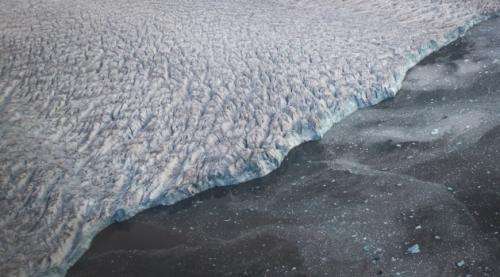Why glaciers that flow into the ocean are extremely sensitive to climate

In a new paper published in the journal Nature Geoscience researchers present a new view of iceberg calving that explains the sudden collapse of ice shelves and sudden retreat of tidewater glaciers, observed as the polar region slowly warm.
The authors in this Finnish-Swedish-US-Chinese collaboration suggest that their results and theoretical framework will guide improvements in our ability to estimate future sea levels.
Sea level rise is among the greatest threats due to climate change. Over the next century, ice sheets and glaciers will be one of the main contributors, through melting and calving of ice into the oceans. The amount of calved ice is not easy to reproduce in computer simulations, and due to the rapid and non-linear variability of calving fluxes, they are usually difficult to include in models forced by evolving climatic variables. Simulation of iceberg calving remains one of the grand challenges in preparing for future climate change.
In their new work the researchers combine field data from Svalbard, Alaska, Greenland, and Antarctica with theory and computer simulations.
Their results suggest that calving glaciers and ice sheets behave as self-organised critical systems that fluctuate around a critical point, readily flipping between states of sub-critical advance and super-critical retreat in response to changes in climate and geometric conditions.
"We found that the frequency of observed calving events, ranging from 1 to 1 trillion m3, follow universal scaling laws. This means that the probability of calving events obey a particular pattern no matter if they are small or large events – much like the Gutenberg-Richter law for earthquakes," says Dr. Jan Åström of the CSC – IT Center for Science, Ltd. in Finland.
The observations also agree with their computer simulations, where calving events are modelled as the fracture of millions of individual ice blocks. Cracks will suddenly propagate through the ice blocks, triggering calving events whose size and inter-event time distributions share a striking resemblance to those predicted by a classic theory of self-organised criticality, originally developed as a model of a growing sandpile [the Abelian sandpile model].
"This means that calving is extremely and unavoidably sensitive to its environment: a slight climate change can mean the difference between very little calving and the complete disintegration of entire ice shelves," says Dorothée Vallot at Uppsala University, Department of Geoscience.
This new view of iceberg calving explains the observed, sudden collapse of ice shelves and sudden retreat of tidewater glaciers as the polar regions slowly warm.
The authors suggest that their results and theoretical framework will guide improvements in our ability to estimate future sea levels.
More information: Åström, J.A., D. Vallot, M. Schäfer, E.Z. Welty, S. O'Neel, T.C. Bartholomaus, Y. Liu, T.I. Riikilä, J. Timonen, T. Zwinger and J. C. Moore (2014), "Termini of calving glaciers as self-organised critical systems," Nature Geoscience. DOI: 10.1038/ngeo2290
Journal information: Nature Geoscience
Provided by Uppsala University


















